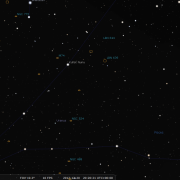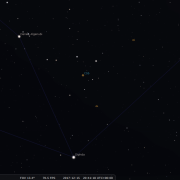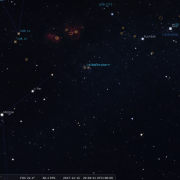Starting this month is a new feature in which we take a brief look at various celestial objects of particular interest for one reason or another. These are a star, a galaxy, a nebula and a cluster. To keep matters simple all the objects are located on or close to the meridian line, due south, around mid month at 20:00h ( GMT time). The objects are ranked as Easy, Medium or a Challenge to observe with the type of optical aid required to spot them.
Star
Eye/Binoculars, Easy/Medium
Omicron Ceti – proper name Mira, known to early astronomers as Mira the Wonderful. Mira is a red giant pulsating variable star that lies approximately 320 light-years away in the constellation Cetus the Whale. Each ‘pulse’ lasts a decade or more, with 10,000 year intervals between each pulse, Mira increasing in luminosity after each pulse. The pulsations of Mira variables (some 7000 are known) cause the star to expand and contract and change its temperature. In Mira, the highest luminosity occurs close to the time when the star is hottest and smallest.
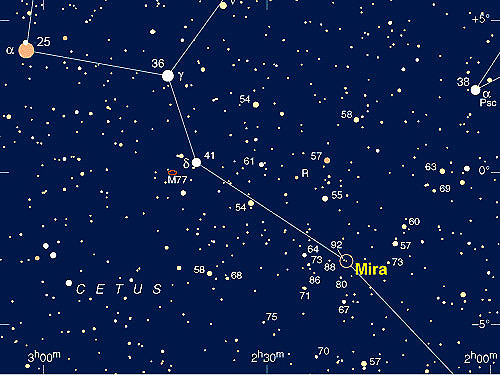
Locating Mira in the Sky (Image Credit: Unknown)
The shorter time scale variability of Mira occur on a regular schedule of about 11 months, typically taking it from mag +3.5, in which case it will easily be seen with the naked eye, right out to mag 10, almost beyond the limit of typical binoculars. Historically Mira has even been recorded at mag +2. Mira’s last brightness peak was in late January 2017 with the next peak scheduled for December 29th 2017. Roughly speaking, Mira reaches its peak a month earlier each year. In 2007 it was discovered that Mira was leaving a trail of hot gas in its wake, resembling a comet- like tail in ultraviolet images and stretching for over 13 light years. Mira has a white dwarf companion star, Mira B, which is accreting some of this material in the form of a proto planetary disk.

Mira appears as a small white dot in the bulb-shaped structure at right, and is moving from left to
right in this view. The shed material can be seen in light blue. The dots in the picture are stars and
distant galaxies. The large blue dot at left is a star that is closer to us than Mira. (NASA/JPL-Caltech)
Galaxy
Medium, Telescope
Messier 74 (also known as NGC 628) is a spiral galaxy in the constellation Pisces. M74 is the brightest member of the M74 Group, a group of 5–7 galaxies that lie approximately 31 – 33 million light-years away from Earth. The galaxy contains two clearly defined spiral arms viewed face on and is used as an archetypal example of a grand design spiral galaxy. The galaxy's low surface brightness makes it quite difficult for astronomers to observe in light polluted skies and it is best viewed under low magnification. It is estimated that M74 is home to about 100 billion stars.
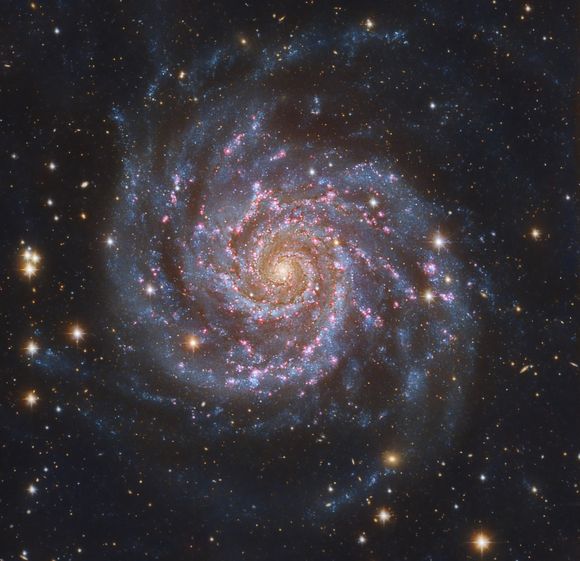
Messier 74/NGC 628: M74 Galaxy (Credit: NASA)
Nebula
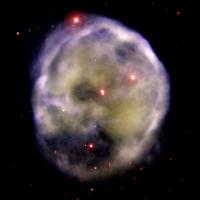
NGC 246 Nebula in Cetus (NASA)
Challenge, Telescope
NGC 246 (C56) Known as the Skull nebula, this interesting planetary nebula discovered by William Herschel in 1785 lies in Cetus, at a distance of 1600 light years and is some 2-3 light years in diameter. You can locate it approximately 6° north-northeast of the 2nd-magnitude star Beta Ceti and about 1.5° south-southeast of 4.8-magnitude Phi1 Ceti.
The complex braided structure of NGC 246’s outer ring, is caused by high-velocity gases pushing outward from the hot (~200,000 K) central star. At mag 10.7 you will require a telescope to spot it, but it is worth it.
Cluster
Easy, Binocular/Telescope
NGC 869 & 884 – the double cluster in Perseus, (often designated h Persei and χ Persei, respectively). At this time of year this stunning object is located near the zenith on the meridian and lies roughly midway between Perseus and Cassiopeia in the sky. The clusters are very young, it's estimated that NGC 869 is 5.6 million years old and NGC 884 only 3.2 million years old. They lie approximately 7500 light years distant and are thought to be separated by around 500 light years. The clusters are approaching us at 24 miles per second. Estimates vary as to how many stars are contained within the clusters, but between them they contain over 400 hot blue-white super massive and super luminous giant stars. Known from antiquity, the clusters can be seen with the naked eye and binoculars, but at low magnification through a scope they really are exquisite, one of the best objects for a smaller instrument.
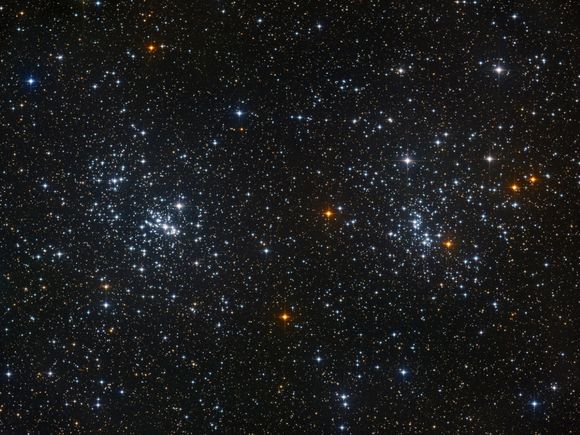
NGC 869 & 884: Double Cluster in Perseus (Credit: NASA)
- Log in to post comments

